
Ceresana has analysed the European market for bio-based paints and coatings, including products for interior and exterior building applications, as well as industrial coatings. Often marketed under names such as natural paints, organic paints, eco paints, or even vegan paints, these green coatings are made entirely—or at least partially—from natural raw materials or minerals.
Natural dyes, once commonplace in construction, were largely displaced by acrylic, vinyl, and other synthetic paints. However, renewable raw materials are now being rediscovered as part of the bioeconomy and circular economy. While bio-based paints currently represent only a small segment of the overall market, sales are rising sharply.
The report not only provides market data and forecasts for bio-based coatings
but also offers background on the regulatory framework of the European paints and coatings industry, as well as insights into the general economic climate and the construction sector—including key companies, construction activity, and investments—across individual countries.
The exact meaning of ‘bio-based’ is defined differently by various certification bodies and eco-labels such as the German ‘Blue Angel’, the Austrian ‘Umweltzeichen’, or the ‘Nordic Swan’. Ideally, raw materials should come from sustainable agriculture, forestry, or fisheries and remain as unaltered as possible. Main components such as pigments, binders, solvents, and fillers can be derived from plant starch, tree resins, mussel shells, or even chicken feathers, reducing dependence on crude oil and natural gas while utilising previously unused biomass waste.
Although not yet suitable for all applications and often more costly than petrochemical alternatives, organic coatings are lauded for their health and environmental benefits. They can be used in combination with other sustainable building materials, such as bio-based insulation, adhesives, and bioplastics. Some bio-based paints even outperform fossil-based products in areas like colour stability, abrasion resistance, viscosity, and coverage.
Natural pigments offer a wide colour spectrum, and diffusion-open paints help prevent condensation and mould by allowing moisture to pass through, be stored, and released again. Above all, these coatings are largely free from toxic additives, making them suitable for sensitive areas such as children’s rooms. The full declaration of ingredients benefits people with allergies or chemical sensitivities, while biodegradable residues reduce hazardous waste disposal costs.
European Market Insights
- Chapter 1 of Ceresana’s report provides a comprehensive analysis of the European market for bio-based paints and coatings, including forecasts to 2034 and data on demand (in tonnes) and revenue (in USD and EUR). Key applications examined include construction, industry, transport, wood processing, and other uses.
- Chapter 2 explores the largest national markets for bio-based paints and coatings across 16 European countries, analysing market size by application and revenue.
- Chapter 3 offers detailed company profiles for 33 major European manufacturers, including DAW SE, BASF SE, Akzo Nobel N.V., IVM S.r.l., Beckers Group, Tikkurila Oyj, and Renner Italia S.P.A., with information on contact details, financials, product ranges, production sites, and summaries.